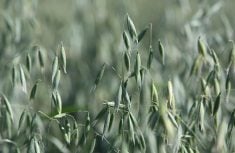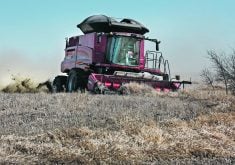Nutritional stress in horses
STILLWATER, Oklahoma – In cold weather, consideration should be given to nutrition and shelter for horses, said Dave Freeman, Oklahoma State University equine specialist.
Fat cover, hair thickness, acclimatization of the horse to cold, hair-coat wetness and wind-chill all affect how horses feel the cold, Freeman said.
A horse with short hair, exposed to wet and cold weather, may need a lot more energy to keep warm. A horse used to cold weather, with a thick hair coat and fat cover, may not use much more energy until the temperature drops below freezing.
Read Also

VIDEO: Ag in Motion documentary launches second season
The second season of the the Western Producer’s documentary series about Ag in Motion launched Oct. 8.
But it is unpractical to boost feed enough to offset the effects of the cold.
“That’s why horses need to be preconditioned for cold weather by increasing fat thickness and body condition before the onset of winter,” Freeman said. A horse manager can’t just provide additional feed to offset loss of body condition.
“Sudden changes in grain composition and amounts will increase the incidence of colic and founder,” he said.
“It’s best to make adjustments in grain gradually over a period of several days, especially if horses already are consuming large quantities of grain.”
Horse managers also should consider feeding large amounts of grass hay to horses restricted from forage. Free-choice hay helps because of the heat generated by digestion and is also an aid to a continual, safe supply of nutrients.
Unfortunately, large hay losses usually occur when round bales are placed on the ground in horse pens.
“Those who have elevated hay feeders large enough to hold round bales need to use them,” Freeman said.
If hay gets wet, generally it will have to be removed because of decreased palatability and mould. Shelter from wind and cold is also important.
“Owners housing horses in areas unprotected from wet, windy weather should consider constructing windbreaks or sheds,” he said. “The cost of windbreaks and sheds will be partially offset by savings in feed costs as a horse’s energy requirements lessen.”
Consider horse instincts and herd pecking orders when deciding on windbreaks and shed design. One or two compatible horses can be housed in an enclosed shed with three or four sides.
The same type of structure will not work in pens with many horses or herds of horses with large ranges in dominance. Lead horses won’t give access to those less dominant.
Freeman recommends single-sided windbreaks with a top cover in herds with a dominance problem. Owners should consider two or three windbreaks spread around the area because one long structure is easily guarded by dominant horses.
– Oklahoma State University














